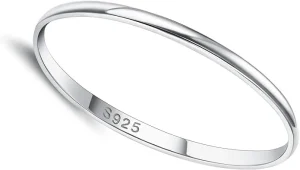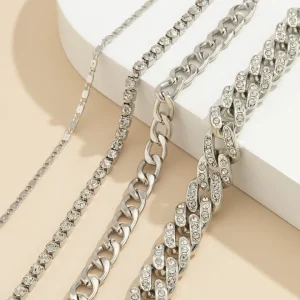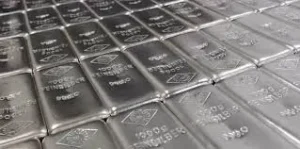Introduction
When you touch the inside of your beloved ring or gaze at the faint “925” engraving on the lock of a necklace, do you wonder about the secrets behind these three numbers? This seemingly random combination is actually the key to unlocking the core value of jewelry – more than 75% of silver jewelry consumers around the world admit that they did not realize the important information carried by this mark at first.
Understanding “925” is not just about satisfying curiosity. It directly determines the jewelry in your hand:
✓ Real value (whether it meets the international sterling silver standard)
✓ Resistance to age (whether the metal structure can withstand daily wear and tear)
✓ Heritage potential (whether it can still shine after decades)
This article will take you on a silver jewelry decoding journey:
◆ Tearing off the chemical veil of “925” – how the 7.5% alloy ratio creates the legend of silver jewelry
◆ Identifying “fake sterling silver” with the naked eye
◆ Maintenance guide: From silver sulfide reaction to ultrasonic cleaning protection strategies
Mastering this knowledge will enable you to:
Lock on the genuine product at a glance in the mixed market
Make oxidation and blackening a historical term
What Does 925 Mean on Jewelry?
Definition
“925” is the international purity mark for silver jewelry, which means that the silver content is 92.5%, and the remaining 7.5% is copper and other metals. This ratio not only retains the soft luster of silver, but also improves the hardness, avoiding the defect of pure silver (999) being too soft and easy to deform, and is called standard pure silver (Sterling Silver).
Why has “925” become the global standard?
For performance balance: the alloy combination of 92.5% silver + 7.5% copper perfectly balances ductility, wear resistance and oxidation resistance, and is suitable for making fine jewelry.
Historical authority: It originated from the British “Sterling Silver Coin” standard (92.5% silver purity) in the 13th century, and was later solidified by the international trade system.
International certification: Global jewelry associations (such as the US ASTM and China GB/T) all use 925 as the pure silver benchmark to ensure consistency in cross-border circulation.
The history behind the 925 standard:
Origin in the Middle Ages: In 1300, Edward I of England issued the Silver Act, stipulating that silver coins must contain 92.5% silver, thus laying the foundation for the “Sterling Silver” system.
Promoted by the Industrial Revolution: In the 19th century, the European jewelry industry used the 925 standard for tableware and jewelry to solve the practical defects of pure silver.
Modern globalization: In the early 20th century, American brands such as Tiffany promoted 925 silver jewelry, which was eventually adopted by the ISO international standard (ISO 9202) and is still used today.

Understanding Sterling Silver: Composition and Standards
Pure silver refers to metals with a silver content of ≥99.9%. However, because it is too soft and fragile, the international standard silver (Sterling Silver) stipulates that the silver content is 92.5% (marked as 925), and the remaining 7.5% is copper and other alloys to balance practicality and beauty.
The role of alloys in enhancing silver’s properties.
Enhancing hardness: Copper and other metals improve wear resistance and avoid the defects of pure silver that are easy to scratch and deform.
Anti-tarnishing: Alloys slow down the sulfidation reaction and delay the oxidation and blackening speed of silver jewelry.
Shaping optimization: Enhanced ductility can be made into jewelry with more appearances and styles.
Why 92.5% purity is optimal
When the silver content is ≥92.5%, the metal still retains the warm luster and ductility of silver; 7.5% alloy increases the hardness by 300%, which can withstand the pressure of daily wear; higher than this purity, the processing loss increases sharply, and lower than this purity loses the characteristics of silver jewelry.
Why Not 100% Pure Silver?
100% silver is too soft for practical jewelry.
100% pure silver is too soft and can be easily deformed. The ring can be bent with a light pressure of the finger, and the silver ear needles can also be easily bent. In addition, 100% pure silver is not scratch-resistant. A slight bump will leave scratches. Without the protection of the alloy layer, the gloss of its surface will quickly fade. Because 100% pure silver is too soft, its functionality is also poor. It is basically impossible to stably inlay gemstones and carve complex textures.
How adding metals improves durability without losing beauty.
The intelligent proportion of the alloy, by adding 7.5% copper/zinc/germanium and other metals:
→ Strength improvement: hardness increased to 3.5-4 (close to platinum), deformation resistance increased by 200%;
→ Color balance: copper and silver have similar atomic radius, and the alloy still maintains a silvery white color (no obvious redness when the copper content is <10%);
→ Oxidation regulation: zinc element reacts with sulfur first, slowing down the speed of silver sulfidation and blackening.
The 7.5% alloy addition is the “magic threshold” in materials engineering, achieving a perfect compromise between the softness of silver and the toughness of metal.

How to Identify 925 Jewelry
Look for Hallmarks
Look for the engraved “925”, “S925”, “Sterling” or “Ster”, which are usually located on the inner ring of the ring, necklace buckle, bracelet buckle or earring pin. Some silver-plated jewelry will be marked “Silver Plated” or “FS” (imitation silver) instead of 925.
Physical Characteristics
Color: 925 silver is warm grayish white, compared with the cold white light of nickel plating/stainless steel
Weight: Density 10.4g/cm³, slightly heavier than white copper (8.9g/cm³)
Touch: Fast heat conduction (strong cold feeling at the beginning of wearing), mild oxidation luster after long-term wearing
Testing Methods
Home testing:
▸ Magnet repulsion: Pure silver is non-magnetic (iron-containing alloys will be adsorbed)
▸ Sulfur soap test: Rapid oxidation and blackening after friction (fake silver plating has no reaction)
Professional identification:
▸ Nitric acid spot test: Milky white turbidity after dripping nitric acid (copper-zinc alloy turns green)
▸ X-ray fluorescence: Accurate analysis of metal component ratio (error <0.1%)
The Advantages of 925 Sterling Silver Jewelry
Durability
Pure silver is more durable than pure silver and is the preferred material for daily wear. The 7.5% alloy has a Mohs hardness of 3.5, and its scratch resistance is 30% higher than that of 100% silver.
Hypoallergenic Properties
It has passed the EU REACH nickel release certification (<0.2μg/cm²/week), making it a safe choice for people with sensitive skin. It can significantly reduce the risk of irritation or allergic reactions.
Affordability
Compared with gold or platinum, pure silver looks luxurious and is more affordable, with a unit price of only 1/50 of gold and 1/30 of platinum.
925 vs. Other Jewelry Marks (e.g., 999, 585, 750)
| Mark | Metal Type | Purity Level | Details |
|---|---|---|---|
| 925 | Sterling Silver | 92.5% Pure Silver | Mixed with 7.5% other metals, usually copper, for durability. |
| 999 | Fine Silver | 99.9% Pure Silver | Very soft; rarely used for jewelry due to lack of durability. |
| 585 | 14K Gold | 58.5% Pure Gold | Mixed with alloys for strength; popular for everyday gold jewelry. |
| 750 | 18K Gold | 75% Pure Gold | Higher gold content with a richer color; commonly used in luxury jewelry. |
Is 925 Jewelry Worth Anything?
925 jewelry is a light luxury consumer product. As of early 2025, the price of silver is about $25 to $30 per ounce, but the labor cost often accounts for 30-60%.
Tiffany 1837 series bracelet (sold for $300 in 2000, now second-hand price $500+)
Special craft antique silverware appreciates 5-8% annually (data source: Sotheby’s 2022 jewelry auction report) Therefore, high-quality 925 silver jewelry from well-known brands or designers is much more valuable than sterling silver itself.
When 925 is an excellent investment.
A 2024 survey by the Jewelry Consumer Opinion Council found that more than 65% of respondents preferred sterling silver for everyday jewelry over other, more expensive metals.
Silver price rises 436% in 50 years ($0.95/oz in 1973 → $25/oz in 2024)
Designer collaborations can resell for premiums of up to 200% (like the Chrome Hearts Basic Hanging Tag), and from a monetary investment perspective, silver is less volatile than gold, but also offers lower returns. However, for lifestyle investments (buying jewelry to wear every day), sterling silver performs particularly well.
Silver prices have historically risen during times of economic uncertainty: for example, between 2020 and 2021, they rose more than 46%, according to the London Bullion Market Association (LBMA).

Unlock Smart Spending with 925 Silver Knowledge
We’ve covered how to identify authentic 925 jewelry, why it’s the material of choice for both casual and formal designs, and why it’s a smart lifestyle investment.
Armed with this knowledge, you can now buy sterling silver with confidence and avoid fakes. The next time you see that little “925” stamp, you’ll know what it means.
